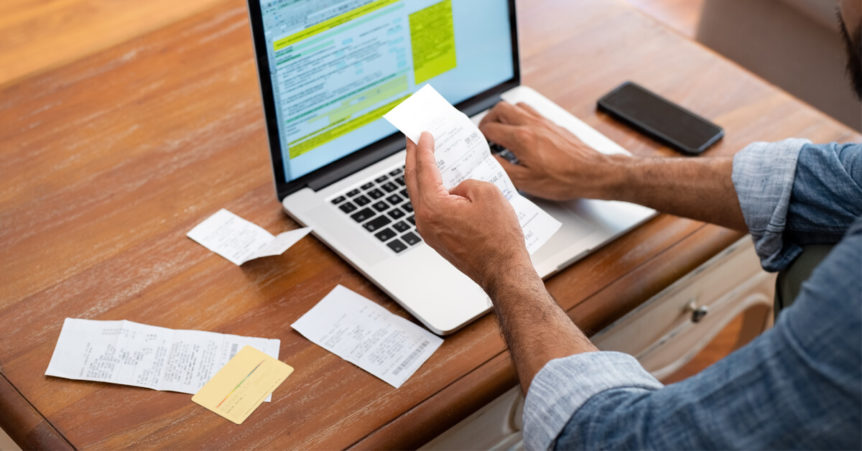I frequently get asked the question, do I have to keep the original copies of receipts and invoices as backup for expense deductions taken on my income tax returns in case of an IRS Audit?
The organizational convenience and compact storage capability of digital medium is an easy sell for most clients but doubts about the validity of digital receipts persist. It would certainly be inconvenient to have the IRS reject your digital documents in the event of an audit.
Fortunately, the answer to the above question is no, so long as you keep scanned, digital copies of the receipts and invoices organized and readily available. Since 1997 the IRS has accepted scanned copies of receipts and invoices so long as they include all the information included on the original receipt.
Read on to learn more about the specific IRS policies regarding digital receipts, software tools to help you keep your documents organized, and the benefits of keeping digital records.
What Are the IRS Rules and Regulations?
According to IRS guidelines, valid receipts should include the amount spent, location, date, and type of expense. Additionally, it’s best if your receipts are dated close to or at the time of purchase. Your records don’t have to be limited to receipts, either. You can include bills and canceled checks as part of your expense documentation.
So, what is the IRS policy surrounding digital receipts?
In IRS Revenue Procedure 97-22, issued in 1997, it states that taxpayers who keep digital records may do so as long as they follow the guidelines set in place by section 6001 of the Internal Revenue Code. Additionally, the software you use must be able to index, store, and retrieve legible copies of your records and transfer them back to hard copy.
Essentially, digitizing your records is permissible provided the documents are readable and contain all the information necessary for your auditor. Feel free to read the regulations on your own, but remember, your tax preparer can also answer any specific questions you may have.
3 of the Best Receipt Scanners and Trackers
To make the process of digitizing and organizing your receipts easier, you can choose from several scanning and tracking programs. Here’s a rundown of some of the best programs you could use, according to the balance: small business.
1. Expensify: Rated Best Overall
Expensify is extremely versatile. You can use it to track your expenses, mileage, and time. Your employees can send you expense reports for your approval, and you can reimburse them electronically. Additionally, you can collect receipts from your customers.
You can use your phone to take a photo of your receipt, and the app will read the relevant details. You can then tag the receipt to the appropriate category.
2. Shoeboxed: Rated Best for Tax Purposes
Like Expensify, Shoeboxed can filter relevant details from your receipts, and you can also use it to track mileage. The most significant difference is you can mark the receipts with deductible expenses for your tax preparer’s convenience. You can even export your expenses to your accounting software.
3. Wave: Rated Best for Small Businesses
For small business owners and freelancers, Wave is a great software option. It allows you to take photos of your receipts and pull the relevant data for your records. It differs from the previously mentioned technologies in that you can’t track mileage. Additionally, if you use Wave, you must use their proprietary accounting software.
All of the above software uses your phone camera to take photos of your receipts, but you can also use an external scanner to digitize your receipts, if you prefer.
Learn More about Digital Receipt Storage
This blog post touches on the basics of digital storage and IRS policies, but you may have more specific questions applicable to your situation. If that’s the case, consult your tax preparer and bookkeeping professional for best practices in digital receipt storage and a digital filing system.
For small business owners and freelancers, Wave is a great software option. It allows you to take photos of your receipts and pull the relevant data for your records. It differs from the previously mentioned technologies in that you can’t track mileage. Additionally, if you use Wave, you must use their proprietary accounting software.
All of the above software uses your phone camera to take photos of your receipts, but you can also use an external scanner to digitize your receipts, if you prefer.
Benefits of Keeping Digital Copies of Receipts
Since you now know the IRS will accept your digital receipts, and you’re aware of some of the best software you can use to digitize your records, you must decide if this storage method is right for you.
Keeping digital copies of invoices and receipts provides many benefits:
- Requires Less Physical Storage: It reduces the need to save and file paper and saves space.
- Avoids Degradation of Physical Documents: Many of our receipts are printed on thermal paper which fades over time; the quality of the image of a digital copy does not degrade.
- Enhances Record Keeping: Many accounting systems allow you to attach the scanned receipt or invoice to the specific transaction in the accounting system, providing immediate backup for the transaction.
Of course, digitally stored records may still be lost or damaged if something happens to your computer hard drive, so if you store your receipts digitally, make sure you have a backup copy saved somewhere safe.
Learn More about Digital Receipt Storage
This blog post touches on the basics of digital storage and IRS policies, but you may have more specific questions applicable to your situation. If that’s the case, consult your tax preparer and bookkeeping professional for best practices in digital receipt storage and a digital filing system.

